From Firm-Controlled to Consumer-Contributed: Marketing Communication
VerifiedAdded on 2023/04/25
|51
|17981
|381
Report
AI Summary
This research paper investigates the evolution of marketing communication from firm-controlled to consumer-contributed models, particularly within the context of personal media. The study explores the adaptation of co-production strategies from service marketing to enhance communication effectiveness. Through eleven field experiments and a structural model, the researchers demonstrate that a co-produced direct marketing communication strategy, such as text message mobile coupons, increases attitude toward the communication, purchase intent, and purchase activity, while also acting as a risk-reducing mechanism. The paper introduces a push versus pull framework and a co-produced communication framework, offering practical insights for marketers to integrate consumers into the communication process. The findings highlight the importance of perceived customization and its interaction with risk perception and coupon proneness in shaping consumer responses. The research contributes to marketing theory by extending service principles to marketing communication and provides empirical evidence supporting the benefits of consumer co-production in the digital age.
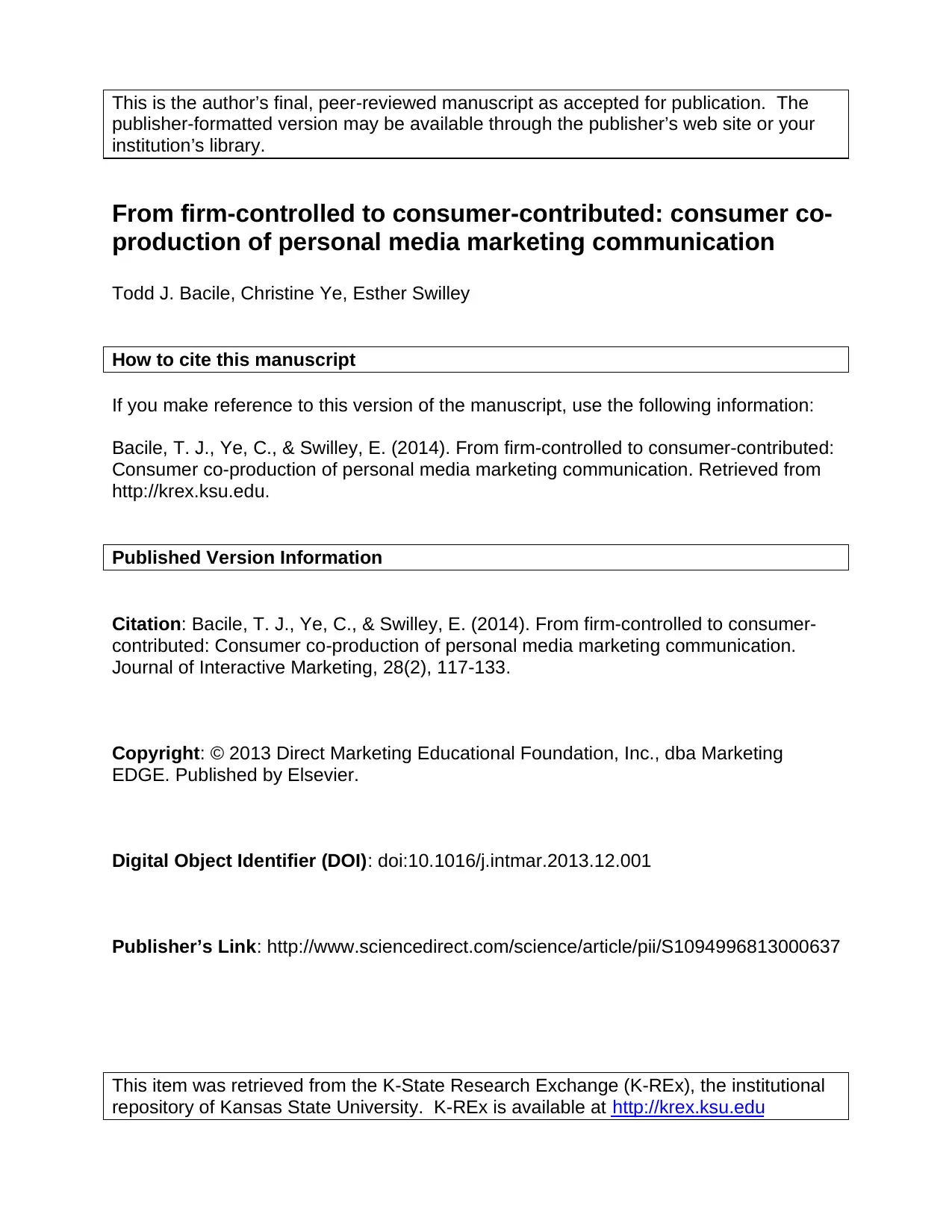
This is the author’s final, peer-reviewed manuscript as accepted for publication. The
publisher-formatted version may be available through the publisher’s web site or your
institution’s library.
This item was retrieved from the K-State Research Exchange (K-REx), the institutional
repository of Kansas State University. K-REx is available at http://krex.ksu.edu
From firm-controlled to consumer-contributed: consumer co-
production of personal media marketing communication
Todd J. Bacile, Christine Ye, Esther Swilley
How to cite this manuscript
If you make reference to this version of the manuscript, use the following information:
Bacile, T. J., Ye, C., & Swilley, E. (2014). From firm-controlled to consumer-contributed:
Consumer co-production of personal media marketing communication. Retrieved from
http://krex.ksu.edu.
Published Version Information
Citation: Bacile, T. J., Ye, C., & Swilley, E. (2014). From firm-controlled to consumer-
contributed: Consumer co-production of personal media marketing communication.
Journal of Interactive Marketing, 28(2), 117-133.
Copyright: © 2013 Direct Marketing Educational Foundation, Inc., dba Marketing
EDGE. Published by Elsevier.
Digital Object Identifier (DOI): doi:10.1016/j.intmar.2013.12.001
Publisher’s Link: http://www.sciencedirect.com/science/article/pii/S1094996813000637
publisher-formatted version may be available through the publisher’s web site or your
institution’s library.
This item was retrieved from the K-State Research Exchange (K-REx), the institutional
repository of Kansas State University. K-REx is available at http://krex.ksu.edu
From firm-controlled to consumer-contributed: consumer co-
production of personal media marketing communication
Todd J. Bacile, Christine Ye, Esther Swilley
How to cite this manuscript
If you make reference to this version of the manuscript, use the following information:
Bacile, T. J., Ye, C., & Swilley, E. (2014). From firm-controlled to consumer-contributed:
Consumer co-production of personal media marketing communication. Retrieved from
http://krex.ksu.edu.
Published Version Information
Citation: Bacile, T. J., Ye, C., & Swilley, E. (2014). From firm-controlled to consumer-
contributed: Consumer co-production of personal media marketing communication.
Journal of Interactive Marketing, 28(2), 117-133.
Copyright: © 2013 Direct Marketing Educational Foundation, Inc., dba Marketing
EDGE. Published by Elsevier.
Digital Object Identifier (DOI): doi:10.1016/j.intmar.2013.12.001
Publisher’s Link: http://www.sciencedirect.com/science/article/pii/S1094996813000637
Paraphrase This Document
Need a fresh take? Get an instant paraphrase of this document with our AI Paraphraser

1
From Firm-Controlled to Consumer-Contributed: Consumer Co-Production of Personal
Media Marketing Communication
Todd J. Bacile
Loyola University New Orleans, Joseph A. Butt, S.J., College of Business, 6363 St. Charles
Avenue, New Orleans, LA 70118, USA
Christine Ye
Westminster College, Bill and Vieve Gore School of Business, 1840 South 1300 East, Salt Lake
City, UT 84105, USA
Esther Swilley
Kansas State University, College of Business Administration, Department of Marketing, 201A
Calvin Hall, Manhattan, KS 66506-0506, USA
From Firm-Controlled to Consumer-Contributed: Consumer Co-Production of Personal
Media Marketing Communication
Todd J. Bacile
Loyola University New Orleans, Joseph A. Butt, S.J., College of Business, 6363 St. Charles
Avenue, New Orleans, LA 70118, USA
Christine Ye
Westminster College, Bill and Vieve Gore School of Business, 1840 South 1300 East, Salt Lake
City, UT 84105, USA
Esther Swilley
Kansas State University, College of Business Administration, Department of Marketing, 201A
Calvin Hall, Manhattan, KS 66506-0506, USA
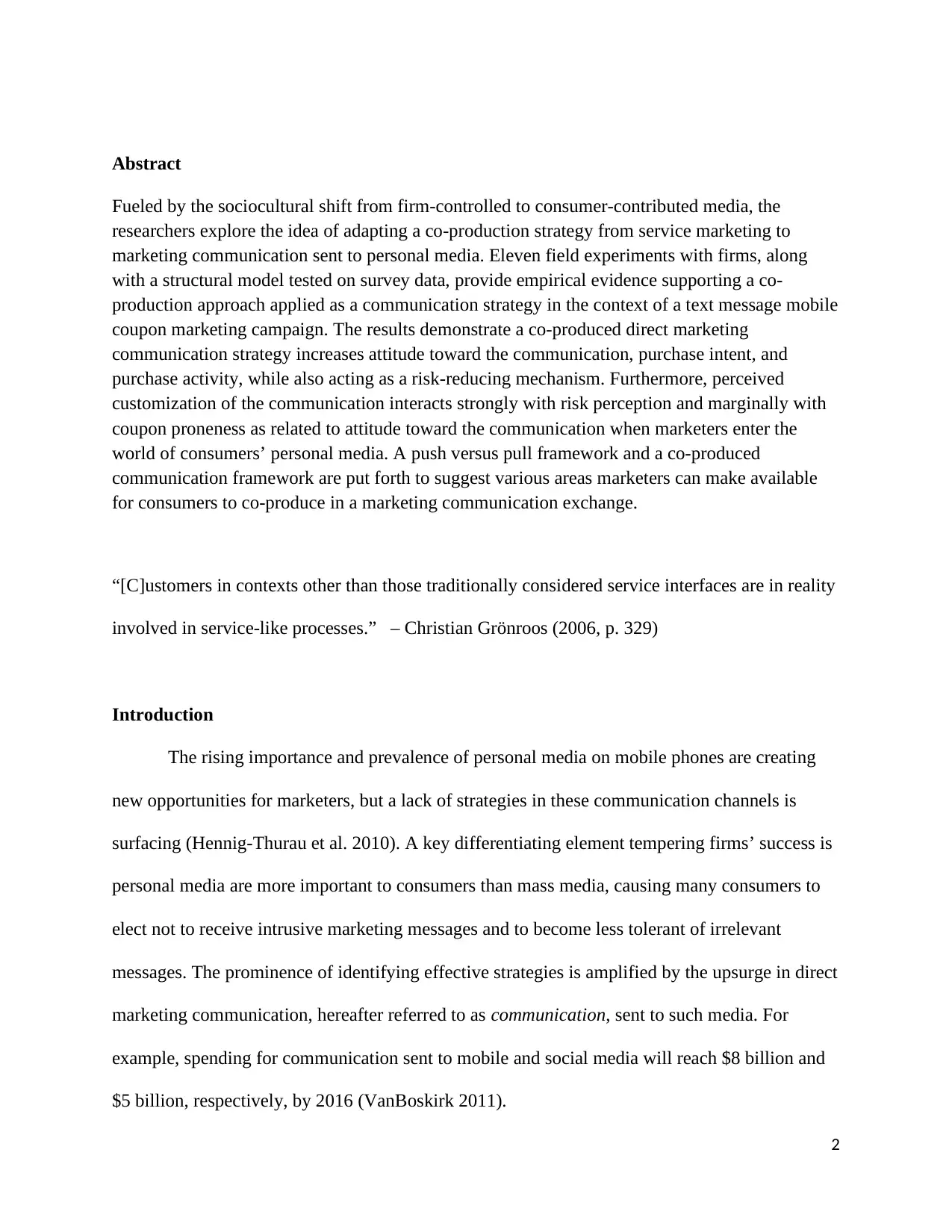
2
Abstract
Fueled by the sociocultural shift from firm-controlled to consumer-contributed media, the
researchers explore the idea of adapting a co-production strategy from service marketing to
marketing communication sent to personal media. Eleven field experiments with firms, along
with a structural model tested on survey data, provide empirical evidence supporting a co-
production approach applied as a communication strategy in the context of a text message mobile
coupon marketing campaign. The results demonstrate a co-produced direct marketing
communication strategy increases attitude toward the communication, purchase intent, and
purchase activity, while also acting as a risk-reducing mechanism. Furthermore, perceived
customization of the communication interacts strongly with risk perception and marginally with
coupon proneness as related to attitude toward the communication when marketers enter the
world of consumers’ personal media. A push versus pull framework and a co-produced
communication framework are put forth to suggest various areas marketers can make available
for consumers to co-produce in a marketing communication exchange.
“[C]ustomers in contexts other than those traditionally considered service interfaces are in reality
involved in service-like processes.” – Christian Grönroos (2006, p. 329)
Introduction
The rising importance and prevalence of personal media on mobile phones are creating
new opportunities for marketers, but a lack of strategies in these communication channels is
surfacing (Hennig-Thurau et al. 2010). A key differentiating element tempering firms’ success is
personal media are more important to consumers than mass media, causing many consumers to
elect not to receive intrusive marketing messages and to become less tolerant of irrelevant
messages. The prominence of identifying effective strategies is amplified by the upsurge in direct
marketing communication, hereafter referred to as communication, sent to such media. For
example, spending for communication sent to mobile and social media will reach $8 billion and
$5 billion, respectively, by 2016 (VanBoskirk 2011).
Abstract
Fueled by the sociocultural shift from firm-controlled to consumer-contributed media, the
researchers explore the idea of adapting a co-production strategy from service marketing to
marketing communication sent to personal media. Eleven field experiments with firms, along
with a structural model tested on survey data, provide empirical evidence supporting a co-
production approach applied as a communication strategy in the context of a text message mobile
coupon marketing campaign. The results demonstrate a co-produced direct marketing
communication strategy increases attitude toward the communication, purchase intent, and
purchase activity, while also acting as a risk-reducing mechanism. Furthermore, perceived
customization of the communication interacts strongly with risk perception and marginally with
coupon proneness as related to attitude toward the communication when marketers enter the
world of consumers’ personal media. A push versus pull framework and a co-produced
communication framework are put forth to suggest various areas marketers can make available
for consumers to co-produce in a marketing communication exchange.
“[C]ustomers in contexts other than those traditionally considered service interfaces are in reality
involved in service-like processes.” – Christian Grönroos (2006, p. 329)
Introduction
The rising importance and prevalence of personal media on mobile phones are creating
new opportunities for marketers, but a lack of strategies in these communication channels is
surfacing (Hennig-Thurau et al. 2010). A key differentiating element tempering firms’ success is
personal media are more important to consumers than mass media, causing many consumers to
elect not to receive intrusive marketing messages and to become less tolerant of irrelevant
messages. The prominence of identifying effective strategies is amplified by the upsurge in direct
marketing communication, hereafter referred to as communication, sent to such media. For
example, spending for communication sent to mobile and social media will reach $8 billion and
$5 billion, respectively, by 2016 (VanBoskirk 2011).
⊘ This is a preview!⊘
Do you want full access?
Subscribe today to unlock all pages.

Trusted by 1+ million students worldwide

3
For our purposes, personal media refers to highly individualized and important
communication tools primarily for interpersonal communication, such as the telephone, chat, text
messaging, and social media through a mobile device (Lüders 2008). The mobile phone is the
platform extraordinaire for such media as it is personal and drives media use. Both the individual
nature and importance of personal media within consumers' lives are apparent (Hennig-Thurau et
al. 2010). As such, psychological barriers exist which firms must overcome when sending
communication through personal media, such as risk perception of a negative outcome including
privacy concerns, irrelevant messages, message volume, and intrusiveness (Deighton and
Kornfeld 2009; Sultan, Rohm, and Gao 2009). Currently, the primary strategy firms use to
reduce risk perception of a negative outcome is to grant consumers the right to opt-in and opt-out
(i.e. give or remove permission) to receive communication sent to personal media (Barwise and
Strong 2002). However, other than these two all-or-nothing inputs, firms typically do not allow
consumers to participate in further decision making inputs into the communication process. This
lack of consumer participation is reminiscent of traditional mass media where the firm views the
consumer as a passive audience member (Wind and Rangaswamy 2001). Aside from opt-in or
opt-out decisions, in both mass and personal media, the time, frequency, subject, and type of
communication are generally decided by marketers. This consistency between mass and personal
media is surprising, considering labels such as "customized" and "personalized" that often
differentiate personal media from mass media (Shankar and Balasubramanian 2009).
The current paper suggests firms view personal media communication as an interactive
process with consumers in contrast to the classic one-way marketing communication model. This
proposed type of exchange positions personal media communication similar to the modern
viewpoint of service as interactive firm-consumer processes. Various service philosophies such
For our purposes, personal media refers to highly individualized and important
communication tools primarily for interpersonal communication, such as the telephone, chat, text
messaging, and social media through a mobile device (Lüders 2008). The mobile phone is the
platform extraordinaire for such media as it is personal and drives media use. Both the individual
nature and importance of personal media within consumers' lives are apparent (Hennig-Thurau et
al. 2010). As such, psychological barriers exist which firms must overcome when sending
communication through personal media, such as risk perception of a negative outcome including
privacy concerns, irrelevant messages, message volume, and intrusiveness (Deighton and
Kornfeld 2009; Sultan, Rohm, and Gao 2009). Currently, the primary strategy firms use to
reduce risk perception of a negative outcome is to grant consumers the right to opt-in and opt-out
(i.e. give or remove permission) to receive communication sent to personal media (Barwise and
Strong 2002). However, other than these two all-or-nothing inputs, firms typically do not allow
consumers to participate in further decision making inputs into the communication process. This
lack of consumer participation is reminiscent of traditional mass media where the firm views the
consumer as a passive audience member (Wind and Rangaswamy 2001). Aside from opt-in or
opt-out decisions, in both mass and personal media, the time, frequency, subject, and type of
communication are generally decided by marketers. This consistency between mass and personal
media is surprising, considering labels such as "customized" and "personalized" that often
differentiate personal media from mass media (Shankar and Balasubramanian 2009).
The current paper suggests firms view personal media communication as an interactive
process with consumers in contrast to the classic one-way marketing communication model. This
proposed type of exchange positions personal media communication similar to the modern
viewpoint of service as interactive firm-consumer processes. Various service philosophies such
Paraphrase This Document
Need a fresh take? Get an instant paraphrase of this document with our AI Paraphraser
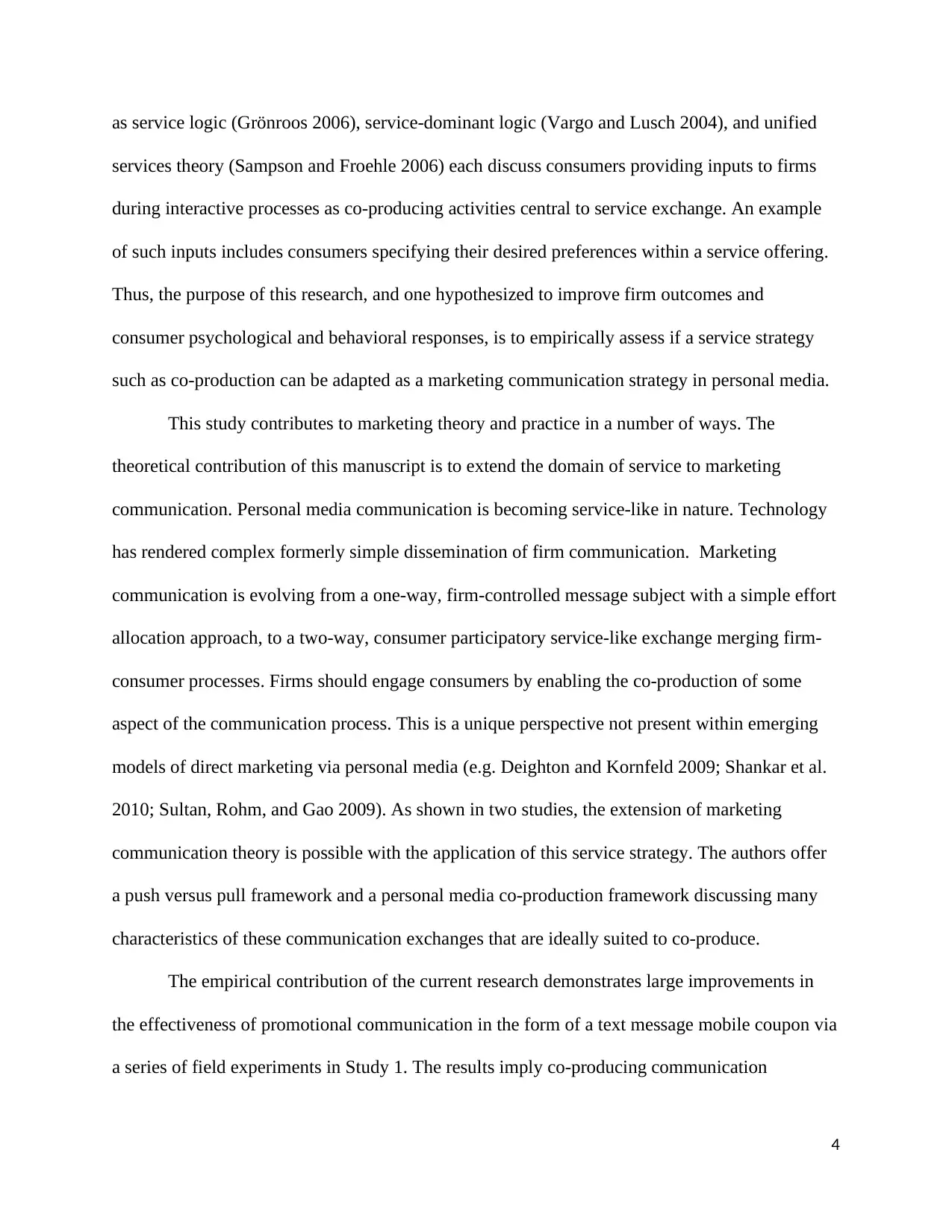
4
as service logic (Grönroos 2006), service-dominant logic (Vargo and Lusch 2004), and unified
services theory (Sampson and Froehle 2006) each discuss consumers providing inputs to firms
during interactive processes as co-producing activities central to service exchange. An example
of such inputs includes consumers specifying their desired preferences within a service offering.
Thus, the purpose of this research, and one hypothesized to improve firm outcomes and
consumer psychological and behavioral responses, is to empirically assess if a service strategy
such as co-production can be adapted as a marketing communication strategy in personal media.
This study contributes to marketing theory and practice in a number of ways. The
theoretical contribution of this manuscript is to extend the domain of service to marketing
communication. Personal media communication is becoming service-like in nature. Technology
has rendered complex formerly simple dissemination of firm communication. Marketing
communication is evolving from a one-way, firm-controlled message subject with a simple effort
allocation approach, to a two-way, consumer participatory service-like exchange merging firm-
consumer processes. Firms should engage consumers by enabling the co-production of some
aspect of the communication process. This is a unique perspective not present within emerging
models of direct marketing via personal media (e.g. Deighton and Kornfeld 2009; Shankar et al.
2010; Sultan, Rohm, and Gao 2009). As shown in two studies, the extension of marketing
communication theory is possible with the application of this service strategy. The authors offer
a push versus pull framework and a personal media co-production framework discussing many
characteristics of these communication exchanges that are ideally suited to co-produce.
The empirical contribution of the current research demonstrates large improvements in
the effectiveness of promotional communication in the form of a text message mobile coupon via
a series of field experiments in Study 1. The results imply co-producing communication
as service logic (Grönroos 2006), service-dominant logic (Vargo and Lusch 2004), and unified
services theory (Sampson and Froehle 2006) each discuss consumers providing inputs to firms
during interactive processes as co-producing activities central to service exchange. An example
of such inputs includes consumers specifying their desired preferences within a service offering.
Thus, the purpose of this research, and one hypothesized to improve firm outcomes and
consumer psychological and behavioral responses, is to empirically assess if a service strategy
such as co-production can be adapted as a marketing communication strategy in personal media.
This study contributes to marketing theory and practice in a number of ways. The
theoretical contribution of this manuscript is to extend the domain of service to marketing
communication. Personal media communication is becoming service-like in nature. Technology
has rendered complex formerly simple dissemination of firm communication. Marketing
communication is evolving from a one-way, firm-controlled message subject with a simple effort
allocation approach, to a two-way, consumer participatory service-like exchange merging firm-
consumer processes. Firms should engage consumers by enabling the co-production of some
aspect of the communication process. This is a unique perspective not present within emerging
models of direct marketing via personal media (e.g. Deighton and Kornfeld 2009; Shankar et al.
2010; Sultan, Rohm, and Gao 2009). As shown in two studies, the extension of marketing
communication theory is possible with the application of this service strategy. The authors offer
a push versus pull framework and a personal media co-production framework discussing many
characteristics of these communication exchanges that are ideally suited to co-produce.
The empirical contribution of the current research demonstrates large improvements in
the effectiveness of promotional communication in the form of a text message mobile coupon via
a series of field experiments in Study 1. The results imply co-producing communication

5
improves consumer response. Using survey data with structural equation modeling then uncovers
mechanisms underlying this effectiveness in Study 2, which hones in on perceived customization
as the key driver behind enhanced response to a firm’s mobile coupon promotion. Risk
perception is present when communication is sent to personal media, and we show a co-
production strategy attenuates this risk. In addition to acting as a risk-reducing mechanism,
results suggest co-production improves attitude toward the communication and purchase intent,
with perceived customization of the communication interacting strongly with risk perception and
marginally with coupon proneness as each relates to attitude toward the communication. The
remainder of this paper discusses communication theory and the theoretical development on the
ways in which personal media communication is evolving toward a service-like offering. The
hypotheses and conceptual model are formulated and assessed in two studies, followed by a
discussion of all findings, theoretical implications, and managerial ramifications.
Theoretical Development
Communication Theory
Marketers using traditional mass media to disseminate communication typically follow a
process consistent with the transmission model of mass communication (Shannon and Weaver
1949). The basis of this model is information processing and communication theory. These steps
within the communication process have been adapted to various communication models, yet the
core steps remain the same. Communication is a process, where a breakdown in any step disrupts
the entire process. A source creates a message by encoding it into a format conducive for a
particular medium. The message is sent via a medium, upon which a receiver must decode the
message. Encoding the proper message containing information of interest to a receiver and using
improves consumer response. Using survey data with structural equation modeling then uncovers
mechanisms underlying this effectiveness in Study 2, which hones in on perceived customization
as the key driver behind enhanced response to a firm’s mobile coupon promotion. Risk
perception is present when communication is sent to personal media, and we show a co-
production strategy attenuates this risk. In addition to acting as a risk-reducing mechanism,
results suggest co-production improves attitude toward the communication and purchase intent,
with perceived customization of the communication interacting strongly with risk perception and
marginally with coupon proneness as each relates to attitude toward the communication. The
remainder of this paper discusses communication theory and the theoretical development on the
ways in which personal media communication is evolving toward a service-like offering. The
hypotheses and conceptual model are formulated and assessed in two studies, followed by a
discussion of all findings, theoretical implications, and managerial ramifications.
Theoretical Development
Communication Theory
Marketers using traditional mass media to disseminate communication typically follow a
process consistent with the transmission model of mass communication (Shannon and Weaver
1949). The basis of this model is information processing and communication theory. These steps
within the communication process have been adapted to various communication models, yet the
core steps remain the same. Communication is a process, where a breakdown in any step disrupts
the entire process. A source creates a message by encoding it into a format conducive for a
particular medium. The message is sent via a medium, upon which a receiver must decode the
message. Encoding the proper message containing information of interest to a receiver and using
⊘ This is a preview!⊘
Do you want full access?
Subscribe today to unlock all pages.

Trusted by 1+ million students worldwide
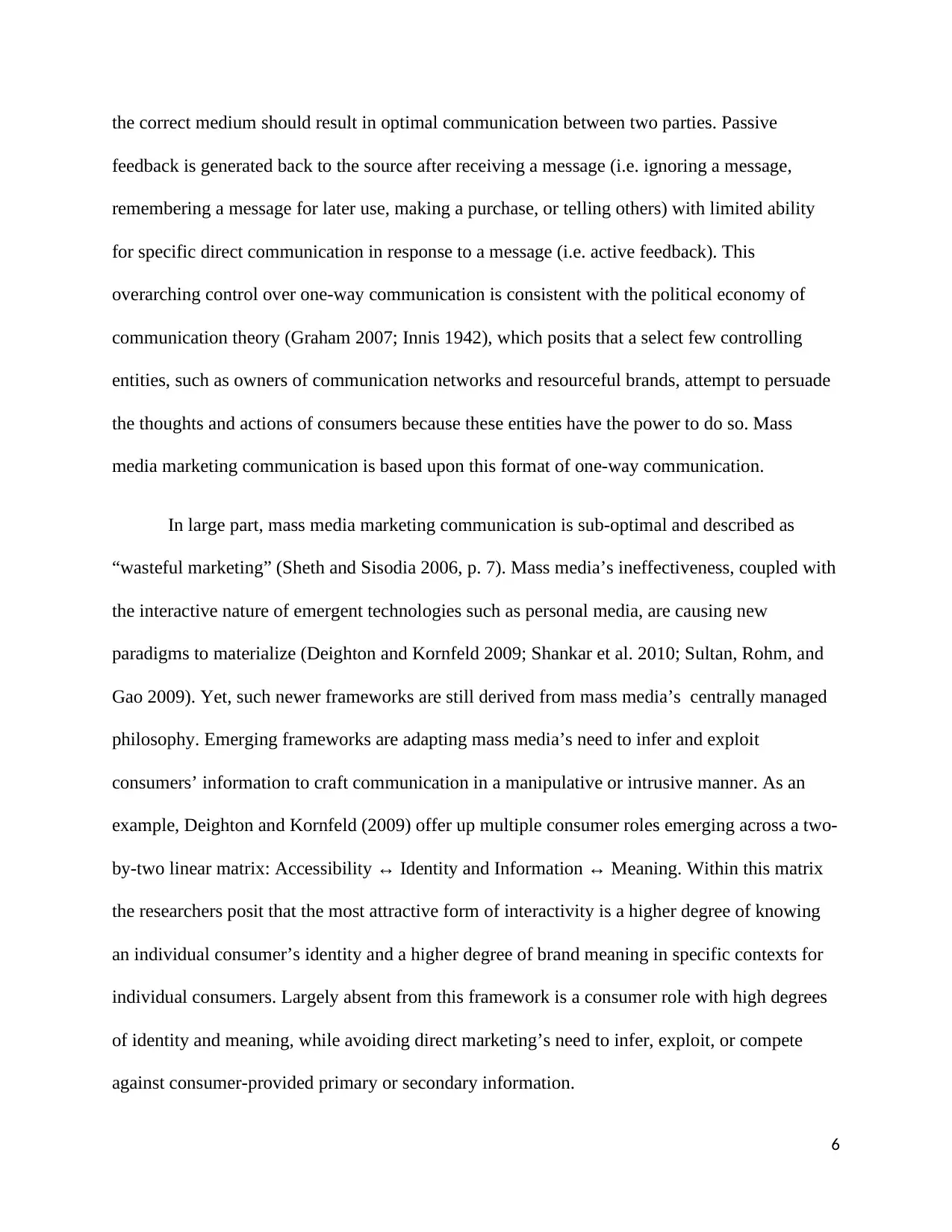
6
the correct medium should result in optimal communication between two parties. Passive
feedback is generated back to the source after receiving a message (i.e. ignoring a message,
remembering a message for later use, making a purchase, or telling others) with limited ability
for specific direct communication in response to a message (i.e. active feedback). This
overarching control over one-way communication is consistent with the political economy of
communication theory (Graham 2007; Innis 1942), which posits that a select few controlling
entities, such as owners of communication networks and resourceful brands, attempt to persuade
the thoughts and actions of consumers because these entities have the power to do so. Mass
media marketing communication is based upon this format of one-way communication.
In large part, mass media marketing communication is sub-optimal and described as
“wasteful marketing” (Sheth and Sisodia 2006, p. 7). Mass media’s ineffectiveness, coupled with
the interactive nature of emergent technologies such as personal media, are causing new
paradigms to materialize (Deighton and Kornfeld 2009; Shankar et al. 2010; Sultan, Rohm, and
Gao 2009). Yet, such newer frameworks are still derived from mass media’s centrally managed
philosophy. Emerging frameworks are adapting mass media’s need to infer and exploit
consumers’ information to craft communication in a manipulative or intrusive manner. As an
example, Deighton and Kornfeld (2009) offer up multiple consumer roles emerging across a two-
by-two linear matrix: Accessibility ↔ Identity and Information ↔ Meaning. Within this matrix
the researchers posit that the most attractive form of interactivity is a higher degree of knowing
an individual consumer’s identity and a higher degree of brand meaning in specific contexts for
individual consumers. Largely absent from this framework is a consumer role with high degrees
of identity and meaning, while avoiding direct marketing’s need to infer, exploit, or compete
against consumer-provided primary or secondary information.
the correct medium should result in optimal communication between two parties. Passive
feedback is generated back to the source after receiving a message (i.e. ignoring a message,
remembering a message for later use, making a purchase, or telling others) with limited ability
for specific direct communication in response to a message (i.e. active feedback). This
overarching control over one-way communication is consistent with the political economy of
communication theory (Graham 2007; Innis 1942), which posits that a select few controlling
entities, such as owners of communication networks and resourceful brands, attempt to persuade
the thoughts and actions of consumers because these entities have the power to do so. Mass
media marketing communication is based upon this format of one-way communication.
In large part, mass media marketing communication is sub-optimal and described as
“wasteful marketing” (Sheth and Sisodia 2006, p. 7). Mass media’s ineffectiveness, coupled with
the interactive nature of emergent technologies such as personal media, are causing new
paradigms to materialize (Deighton and Kornfeld 2009; Shankar et al. 2010; Sultan, Rohm, and
Gao 2009). Yet, such newer frameworks are still derived from mass media’s centrally managed
philosophy. Emerging frameworks are adapting mass media’s need to infer and exploit
consumers’ information to craft communication in a manipulative or intrusive manner. As an
example, Deighton and Kornfeld (2009) offer up multiple consumer roles emerging across a two-
by-two linear matrix: Accessibility ↔ Identity and Information ↔ Meaning. Within this matrix
the researchers posit that the most attractive form of interactivity is a higher degree of knowing
an individual consumer’s identity and a higher degree of brand meaning in specific contexts for
individual consumers. Largely absent from this framework is a consumer role with high degrees
of identity and meaning, while avoiding direct marketing’s need to infer, exploit, or compete
against consumer-provided primary or secondary information.
Paraphrase This Document
Need a fresh take? Get an instant paraphrase of this document with our AI Paraphraser
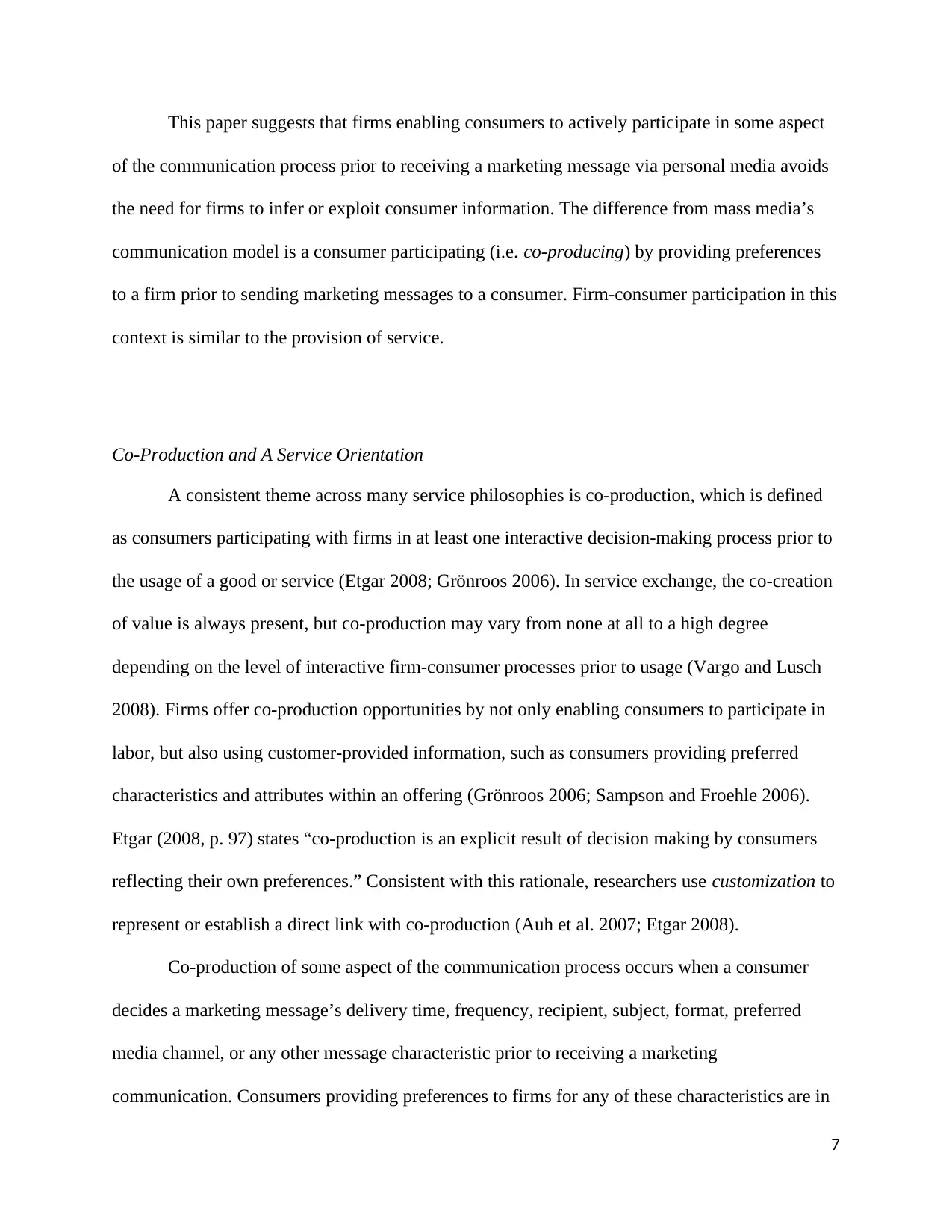
7
This paper suggests that firms enabling consumers to actively participate in some aspect
of the communication process prior to receiving a marketing message via personal media avoids
the need for firms to infer or exploit consumer information. The difference from mass media’s
communication model is a consumer participating (i.e. co-producing) by providing preferences
to a firm prior to sending marketing messages to a consumer. Firm-consumer participation in this
context is similar to the provision of service.
Co-Production and A Service Orientation
A consistent theme across many service philosophies is co-production, which is defined
as consumers participating with firms in at least one interactive decision-making process prior to
the usage of a good or service (Etgar 2008; Grönroos 2006). In service exchange, the co-creation
of value is always present, but co-production may vary from none at all to a high degree
depending on the level of interactive firm-consumer processes prior to usage (Vargo and Lusch
2008). Firms offer co-production opportunities by not only enabling consumers to participate in
labor, but also using customer-provided information, such as consumers providing preferred
characteristics and attributes within an offering (Grönroos 2006; Sampson and Froehle 2006).
Etgar (2008, p. 97) states “co-production is an explicit result of decision making by consumers
reflecting their own preferences.” Consistent with this rationale, researchers use customization to
represent or establish a direct link with co-production (Auh et al. 2007; Etgar 2008).
Co-production of some aspect of the communication process occurs when a consumer
decides a marketing message’s delivery time, frequency, recipient, subject, format, preferred
media channel, or any other message characteristic prior to receiving a marketing
communication. Consumers providing preferences to firms for any of these characteristics are in
This paper suggests that firms enabling consumers to actively participate in some aspect
of the communication process prior to receiving a marketing message via personal media avoids
the need for firms to infer or exploit consumer information. The difference from mass media’s
communication model is a consumer participating (i.e. co-producing) by providing preferences
to a firm prior to sending marketing messages to a consumer. Firm-consumer participation in this
context is similar to the provision of service.
Co-Production and A Service Orientation
A consistent theme across many service philosophies is co-production, which is defined
as consumers participating with firms in at least one interactive decision-making process prior to
the usage of a good or service (Etgar 2008; Grönroos 2006). In service exchange, the co-creation
of value is always present, but co-production may vary from none at all to a high degree
depending on the level of interactive firm-consumer processes prior to usage (Vargo and Lusch
2008). Firms offer co-production opportunities by not only enabling consumers to participate in
labor, but also using customer-provided information, such as consumers providing preferred
characteristics and attributes within an offering (Grönroos 2006; Sampson and Froehle 2006).
Etgar (2008, p. 97) states “co-production is an explicit result of decision making by consumers
reflecting their own preferences.” Consistent with this rationale, researchers use customization to
represent or establish a direct link with co-production (Auh et al. 2007; Etgar 2008).
Co-production of some aspect of the communication process occurs when a consumer
decides a marketing message’s delivery time, frequency, recipient, subject, format, preferred
media channel, or any other message characteristic prior to receiving a marketing
communication. Consumers providing preferences to firms for any of these characteristics are in

8
effect co-producing the communication process. Whereas mass media limit a consumer as an
inactive participant, co-producing the communication process in personal media enables active
participation of a consumer to decide some aspect of a communication prior to receiving. This
communication-based view of co-production is consistent with Etgar’s (2008) service-based
view of co-production. Positing the domain of co-production as applicable to personal media
marketing communication is a logical evolutionary path when one considers the progression
toward the modern understanding of service.
The emergence of a service orientation is expanding the purview of service from earlier
connotations of an intangible act, such as a gas station attendant pumping fuel, to firm-consumer
interactions, exchanges, and processes. The modern definition of service is the application of
interactive firm-consumer processes to create value. This definition captures the essence across
many service philosophies, including service logic (Grönroos 2006), service-dominant logic
(Vargo and Lusch 2004), and unified services theory (Sampson and Froehle 2006).
The Nordic school’s service logic distinguishes a service from a physical good by
proposing that the former is a firm-consumer process exchange (Grönroos 2006). Services are
processes, rather than objects for economic, transactional exchange; and these firm-consumer
processes take place in interactions. Hence, service logic defines service as processes which aim
to solve consumers’ problems through firm-consumer interactions, be it in-person or technology-
mediated. Consumers co-producing service processes are co-creators of value.
Using similar reasoning, service-dominant logic implies all firms are service providers,
with service being the fundamental basis of exchange (Vargo and Lusch 2004; 2008). Service-
dominant logic suggests a shift is occurring, where intangible resources and co-creation of value
through service provision are replacing the traditional view of marketing based on the economic
effect co-producing the communication process. Whereas mass media limit a consumer as an
inactive participant, co-producing the communication process in personal media enables active
participation of a consumer to decide some aspect of a communication prior to receiving. This
communication-based view of co-production is consistent with Etgar’s (2008) service-based
view of co-production. Positing the domain of co-production as applicable to personal media
marketing communication is a logical evolutionary path when one considers the progression
toward the modern understanding of service.
The emergence of a service orientation is expanding the purview of service from earlier
connotations of an intangible act, such as a gas station attendant pumping fuel, to firm-consumer
interactions, exchanges, and processes. The modern definition of service is the application of
interactive firm-consumer processes to create value. This definition captures the essence across
many service philosophies, including service logic (Grönroos 2006), service-dominant logic
(Vargo and Lusch 2004), and unified services theory (Sampson and Froehle 2006).
The Nordic school’s service logic distinguishes a service from a physical good by
proposing that the former is a firm-consumer process exchange (Grönroos 2006). Services are
processes, rather than objects for economic, transactional exchange; and these firm-consumer
processes take place in interactions. Hence, service logic defines service as processes which aim
to solve consumers’ problems through firm-consumer interactions, be it in-person or technology-
mediated. Consumers co-producing service processes are co-creators of value.
Using similar reasoning, service-dominant logic implies all firms are service providers,
with service being the fundamental basis of exchange (Vargo and Lusch 2004; 2008). Service-
dominant logic suggests a shift is occurring, where intangible resources and co-creation of value
through service provision are replacing the traditional view of marketing based on the economic
⊘ This is a preview!⊘
Do you want full access?
Subscribe today to unlock all pages.

Trusted by 1+ million students worldwide

9
exchange of goods. Service-dominant logic defines service as the application of specialized
processes by one entity to benefit another entity. Firms use such processes with consumers to co-
create value. A distinct component of value co-creation is co-production (Vargo and Lusch
2008). Service always co-creates value, yet involving consumers as co-producers is optional.
Unified services theory’s view of service is consistent with service logic and service-
dominant logic. Unified services theory differentiates service processes from non-service
processes by involving a consumer to provide specific inputs into the production of service
(Sampson and Froehle 2006). Production processes that do not require specific consumer inputs
are managed differently, such as mass manufacturing. Groups of consumers contribute ideas and
market research within a manufacturing context, yet their direct inputs are absent (i.e. a specific
product is not produced for a specific consumer based on inputs). Co-production is a method for
a consumer to provide specific inputs into the service production process.
Associating co-production with promotional communication processes separate and
distinct from product offerings may seem incongruent. Research illustrates this incongruence by
often focusing on co-production of a good or service product (e.g. Auh et al. 2007; Bendapudi
and Leone 2003). However, co-production is applicable to underlying process activities and
interactions to exchange information that will ultimately co-create value (Grönroos 2006). Such
processes can produce accurate and useful personal media communication, leading to positive
outcomes for firms and consumers (Duncan and Moriarty 2006).
Co-production of some aspect of the communication process by enabling consumers to
participate by providing preferences supports the notion that communication exchange is a firm-
consumer encounter becoming process-like (Payne, Storbacka, and Frow 2008). Direct marketing
communication sent to personal media is now a construction process based on mutual
exchange of goods. Service-dominant logic defines service as the application of specialized
processes by one entity to benefit another entity. Firms use such processes with consumers to co-
create value. A distinct component of value co-creation is co-production (Vargo and Lusch
2008). Service always co-creates value, yet involving consumers as co-producers is optional.
Unified services theory’s view of service is consistent with service logic and service-
dominant logic. Unified services theory differentiates service processes from non-service
processes by involving a consumer to provide specific inputs into the production of service
(Sampson and Froehle 2006). Production processes that do not require specific consumer inputs
are managed differently, such as mass manufacturing. Groups of consumers contribute ideas and
market research within a manufacturing context, yet their direct inputs are absent (i.e. a specific
product is not produced for a specific consumer based on inputs). Co-production is a method for
a consumer to provide specific inputs into the service production process.
Associating co-production with promotional communication processes separate and
distinct from product offerings may seem incongruent. Research illustrates this incongruence by
often focusing on co-production of a good or service product (e.g. Auh et al. 2007; Bendapudi
and Leone 2003). However, co-production is applicable to underlying process activities and
interactions to exchange information that will ultimately co-create value (Grönroos 2006). Such
processes can produce accurate and useful personal media communication, leading to positive
outcomes for firms and consumers (Duncan and Moriarty 2006).
Co-production of some aspect of the communication process by enabling consumers to
participate by providing preferences supports the notion that communication exchange is a firm-
consumer encounter becoming process-like (Payne, Storbacka, and Frow 2008). Direct marketing
communication sent to personal media is now a construction process based on mutual
Paraphrase This Document
Need a fresh take? Get an instant paraphrase of this document with our AI Paraphraser
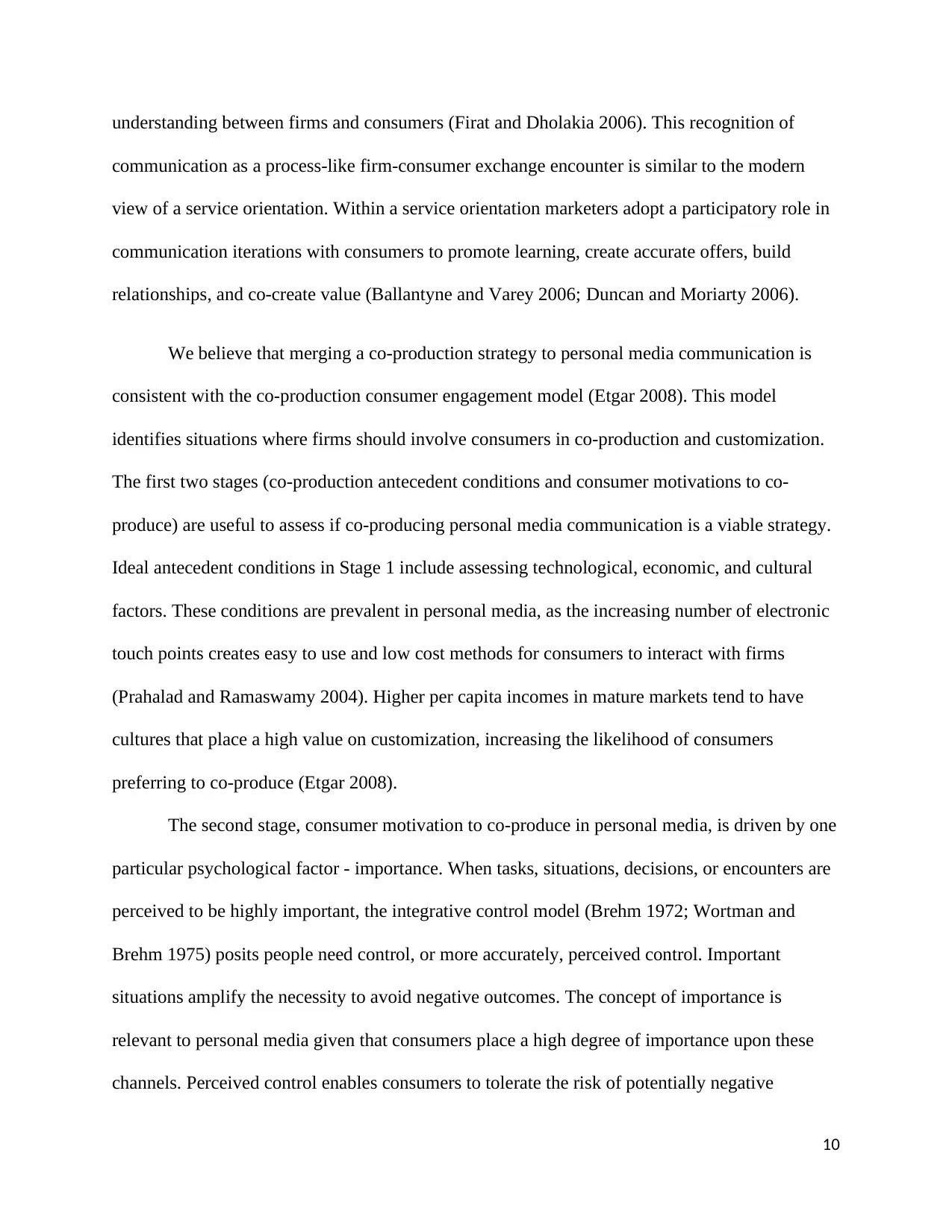
10
understanding between firms and consumers (Firat and Dholakia 2006). This recognition of
communication as a process-like firm-consumer exchange encounter is similar to the modern
view of a service orientation. Within a service orientation marketers adopt a participatory role in
communication iterations with consumers to promote learning, create accurate offers, build
relationships, and co-create value (Ballantyne and Varey 2006; Duncan and Moriarty 2006).
We believe that merging a co-production strategy to personal media communication is
consistent with the co-production consumer engagement model (Etgar 2008). This model
identifies situations where firms should involve consumers in co-production and customization.
The first two stages (co-production antecedent conditions and consumer motivations to co-
produce) are useful to assess if co-producing personal media communication is a viable strategy.
Ideal antecedent conditions in Stage 1 include assessing technological, economic, and cultural
factors. These conditions are prevalent in personal media, as the increasing number of electronic
touch points creates easy to use and low cost methods for consumers to interact with firms
(Prahalad and Ramaswamy 2004). Higher per capita incomes in mature markets tend to have
cultures that place a high value on customization, increasing the likelihood of consumers
preferring to co-produce (Etgar 2008).
The second stage, consumer motivation to co-produce in personal media, is driven by one
particular psychological factor - importance. When tasks, situations, decisions, or encounters are
perceived to be highly important, the integrative control model (Brehm 1972; Wortman and
Brehm 1975) posits people need control, or more accurately, perceived control. Important
situations amplify the necessity to avoid negative outcomes. The concept of importance is
relevant to personal media given that consumers place a high degree of importance upon these
channels. Perceived control enables consumers to tolerate the risk of potentially negative
understanding between firms and consumers (Firat and Dholakia 2006). This recognition of
communication as a process-like firm-consumer exchange encounter is similar to the modern
view of a service orientation. Within a service orientation marketers adopt a participatory role in
communication iterations with consumers to promote learning, create accurate offers, build
relationships, and co-create value (Ballantyne and Varey 2006; Duncan and Moriarty 2006).
We believe that merging a co-production strategy to personal media communication is
consistent with the co-production consumer engagement model (Etgar 2008). This model
identifies situations where firms should involve consumers in co-production and customization.
The first two stages (co-production antecedent conditions and consumer motivations to co-
produce) are useful to assess if co-producing personal media communication is a viable strategy.
Ideal antecedent conditions in Stage 1 include assessing technological, economic, and cultural
factors. These conditions are prevalent in personal media, as the increasing number of electronic
touch points creates easy to use and low cost methods for consumers to interact with firms
(Prahalad and Ramaswamy 2004). Higher per capita incomes in mature markets tend to have
cultures that place a high value on customization, increasing the likelihood of consumers
preferring to co-produce (Etgar 2008).
The second stage, consumer motivation to co-produce in personal media, is driven by one
particular psychological factor - importance. When tasks, situations, decisions, or encounters are
perceived to be highly important, the integrative control model (Brehm 1972; Wortman and
Brehm 1975) posits people need control, or more accurately, perceived control. Important
situations amplify the necessity to avoid negative outcomes. The concept of importance is
relevant to personal media given that consumers place a high degree of importance upon these
channels. Perceived control enables consumers to tolerate the risk of potentially negative
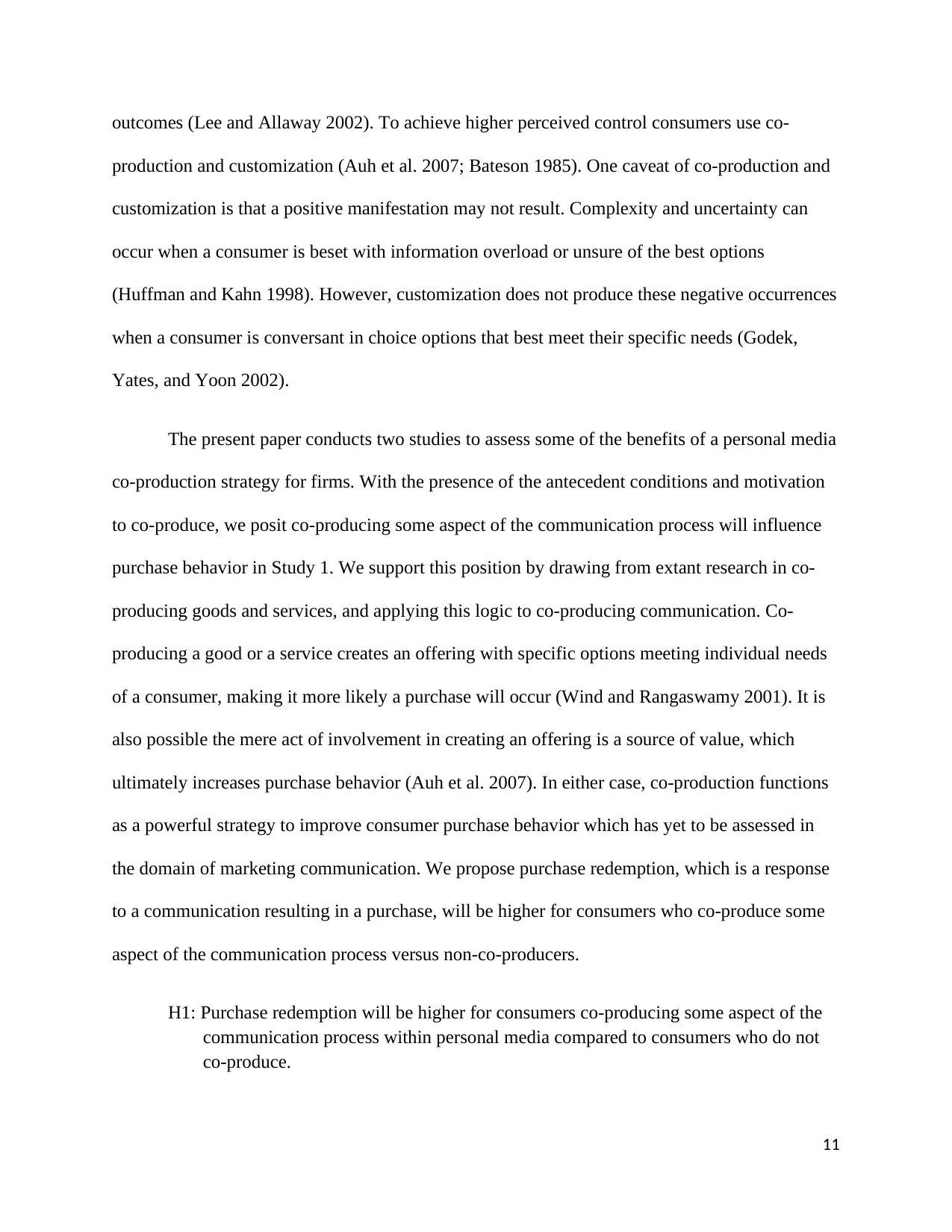
11
outcomes (Lee and Allaway 2002). To achieve higher perceived control consumers use co-
production and customization (Auh et al. 2007; Bateson 1985). One caveat of co-production and
customization is that a positive manifestation may not result. Complexity and uncertainty can
occur when a consumer is beset with information overload or unsure of the best options
(Huffman and Kahn 1998). However, customization does not produce these negative occurrences
when a consumer is conversant in choice options that best meet their specific needs (Godek,
Yates, and Yoon 2002).
The present paper conducts two studies to assess some of the benefits of a personal media
co-production strategy for firms. With the presence of the antecedent conditions and motivation
to co-produce, we posit co-producing some aspect of the communication process will influence
purchase behavior in Study 1. We support this position by drawing from extant research in co-
producing goods and services, and applying this logic to co-producing communication. Co-
producing a good or a service creates an offering with specific options meeting individual needs
of a consumer, making it more likely a purchase will occur (Wind and Rangaswamy 2001). It is
also possible the mere act of involvement in creating an offering is a source of value, which
ultimately increases purchase behavior (Auh et al. 2007). In either case, co-production functions
as a powerful strategy to improve consumer purchase behavior which has yet to be assessed in
the domain of marketing communication. We propose purchase redemption, which is a response
to a communication resulting in a purchase, will be higher for consumers who co-produce some
aspect of the communication process versus non-co-producers.
H1: Purchase redemption will be higher for consumers co-producing some aspect of the
communication process within personal media compared to consumers who do not
co-produce.
outcomes (Lee and Allaway 2002). To achieve higher perceived control consumers use co-
production and customization (Auh et al. 2007; Bateson 1985). One caveat of co-production and
customization is that a positive manifestation may not result. Complexity and uncertainty can
occur when a consumer is beset with information overload or unsure of the best options
(Huffman and Kahn 1998). However, customization does not produce these negative occurrences
when a consumer is conversant in choice options that best meet their specific needs (Godek,
Yates, and Yoon 2002).
The present paper conducts two studies to assess some of the benefits of a personal media
co-production strategy for firms. With the presence of the antecedent conditions and motivation
to co-produce, we posit co-producing some aspect of the communication process will influence
purchase behavior in Study 1. We support this position by drawing from extant research in co-
producing goods and services, and applying this logic to co-producing communication. Co-
producing a good or a service creates an offering with specific options meeting individual needs
of a consumer, making it more likely a purchase will occur (Wind and Rangaswamy 2001). It is
also possible the mere act of involvement in creating an offering is a source of value, which
ultimately increases purchase behavior (Auh et al. 2007). In either case, co-production functions
as a powerful strategy to improve consumer purchase behavior which has yet to be assessed in
the domain of marketing communication. We propose purchase redemption, which is a response
to a communication resulting in a purchase, will be higher for consumers who co-produce some
aspect of the communication process versus non-co-producers.
H1: Purchase redemption will be higher for consumers co-producing some aspect of the
communication process within personal media compared to consumers who do not
co-produce.
⊘ This is a preview!⊘
Do you want full access?
Subscribe today to unlock all pages.

Trusted by 1+ million students worldwide
1 out of 51
Your All-in-One AI-Powered Toolkit for Academic Success.
+13062052269
info@desklib.com
Available 24*7 on WhatsApp / Email
![[object Object]](/_next/static/media/star-bottom.7253800d.svg)
Unlock your academic potential
Copyright © 2020–2025 A2Z Services. All Rights Reserved. Developed and managed by ZUCOL.